From Italy with love
Author
- Lorenzo Baer
Date
- June 17, 2025
Related articles
- 1967 Eifelrennen - When snow fell on the 'Ring, by Lorenzo Baer
- 1968 Argentinian F2 Temporada - The quick dash of the Cavallino Rampante in the Argentinian Pampas, by Lorenzo Baer
- 1969 Tasman Championship - Something that Chris Amon did win, by Tom Prankerd
- 1970 Eifelrennen - When Rindt became a Ringmeister, by Lorenzo Baer
- Jean-Pierre Beltoise - That rainy day in Monaco, by Mattijs Diepraam/Matej Muraus
- Jochen Rindt - Fearless until the end, by Mattijs Diepraam
Who?Carlo Facetti, Enzo Corti What?Tecno F2, Brabham BT23C Where?Vallelunga When?XX Gran Premio di Roma (October 27, 1968) |
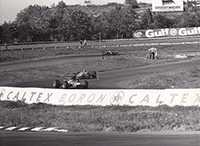 |
Why?
For a regular spectator, the name Ferrari is always linked to the noun 'victory' in the motor racing scenario. The Italian manufacturer's countless laurels in the most diverse disciplines of motorsport, throughout its more than 75 years of activity, seem to be a unanimous tone in the history of Ferrari.
But the most passionate tifosi know that the Scuderia, from time to time, goes through its harsh times. It seems that every two decades or so, the Italian team has its moments of recession, in which the well-fitting machine called 'Ferrari' goes off its axis. Many of these phases leave significant scars in the team's history, as they were moments in which the Scuderia had to make difficult decisions to protect its future, to the detriment of the present.
Certainly, one of the most turbulent moments in Ferrari's history was the period between the end of the 60´s and beginning of the 70´s, where all the factors that destabilized a team converged at one time, in one place: there was a terrible drought of victories, while an internal crisis generated by economic factors undermined the team's morale not only in its Formula 1 department, but also in its Prototype and Touring branches.
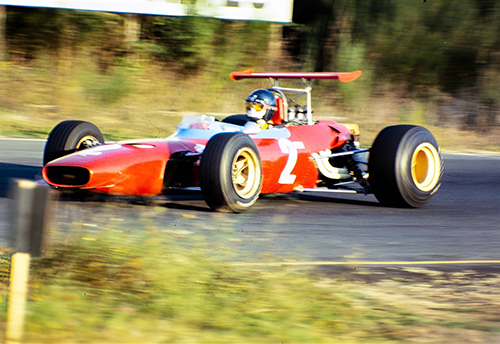
Ernesto 'Tino' Brambilla, the no.1 driver of the Ferrari F2 team in his Ferrari 166 Dino.
With the exception of some punctual successes in the 1967 World Sports Car Championship and Jacky Ickx's surprising victory in the 1968 French Grand Prix, what was left of the manufacturer's racing division's honour was saved by Scuderia's neglected Formula 2 department. This subdivision, between the years 1968 and 1969, would be practically the only one to give some sort of joy to the Italians, as it carried alone on its back the brunt of battle – the one of Ferrari's efforts of winning races.
Thanks to the sleek Dino-Ferrari 166, whether in its original F2 format or its evolution in Tasman specs, the team managed to find a way to the victories, even in the most adverse conditions. And much probably, this car was the best that came out of Ferrari's garages in these turbulent years.
1968 was the year in which these nimble, fast but practically unknown cars shone on the European scene, taking the duo of Ernesto Brambilla and Derek Bell to a level of success that was unthinkable to Ferrari's other motorsport departments during those tough years. One last success was needed to crown the season of these underdogs. And the setting couldn't be better: in the heart of the tarantella land.
The last stop of 1968: Vallelunga
The 1968 Formula 2 season can be summed up in one name: Jochen Rindt. The Austrian, as was typical of his style, put his greatest qualities into practice in the category, being an almost dominant figure in almost all the races in which he entered. Not surprisingly, of the eight official Formula 2 events up until the Rome GP (which would officially close the 1968 European F2 Championship) he had won four of them.
But as Rindt was a graduate and an already established F1 driver, his victories were nothing more than statistics, as he was no longer eligible for the official F2 points table. So, the honour of leading the championship table belonged to Jean-Pierre Beltoise, who had accumulated three victories in the season.
The Frenchman was comfortably leading the standings, as his faithful squire Pescarolo defended second place in the overall ranking. But, with the season coming to its end, a new shadow began to appear in the Matra duo's mirrors, and his name was Ernesto 'Tino' Brambilla.
The Italian triggered a surprising reaction in the final stretch of the season, collecting some great results, such as in the VII Gran Premio del Mediterraneo (a third place) and the I ADAC-Preis von Baden-Württemberg (win). This was a shock to his rivals who did not count on Ferrari to offer strong opposition in the category, as the Scuderia was plunged into complete chaos at the end of 1968.
And just like that, the scene was set for the last round of the 1968 European F2 season, a clash between the surprising but chaotic Ferrari, and the stagnant but linear Matra. Furthermore, the XX Gran Premio di Roma was expected to attract a good number of other entries that would populate the grid with further drivers having regularly competed in F2 during the year.
Assembling the grid
28 cars were originally entered for the XX Gran Premio di Roma, with 23 actually showing up for the practice sessions. As highlighted, Matra was expected to be one of the main contenders, mainly due to the characteristics of the Vallelunga circuit.
Beltoise's three victories in the season were achieved on tracks with mostly high-speed corners (at the Grote Prijs van Zandvoort – Zandvoort; at the II Deutschland Trophäe – Hockenheim; and at the II Gran Premio de Madrid – Jarama) and Vallelunga was no exception to this rule. The MS7-05 chassis that had provided him with each of these triumphs would also be retained for the driver in this race.
Henri Pescarolo, even if he had not had as many impressive results as his teammate, was also in good spirits for the race in Rome. A steady series of good results in the second half of the season had mathematically guaranteed second place in the standings for the other Matra Sports representative. Even though the France-bleu cars enjoyed this 'blasé status', having already achieved all their main objectives for the year, this did not mean that Matra would give up on the race. On the contrary, the same logistics that had accompanied the team so far at all rounds would be put into work once again.
But to say that Matra was the favourite to win the race would be a lie. As incredible as it may seem, Scuderia Ferrari was the most likely outfit to keep the Rome GP trophy in the Italian hands. This was due to two factors: the first was due to the rising performance of the team's cars in the last races, the second was because Vallelunga had served as a testing site for the Dino 166 F2s throughout its process of maturation. Therefore, the team had a reasonable knowledge of the location, in addition to already having an idea of the car's behaviour in track conditions closer to those of a real race.
In addition to the regular duo formed by Italian Tino Brambilla and Briton Derek Bell, a third car was entered in the race for Andrea De Adamich. Originally, it was planned for De Adamich to be the team's second driver for the whole 1968 F2 campaign, but a serious accident in March in the non-championship F1 Race of Champions prevented the Italian driver from exercising his contract with Ferrari.
That was one of the reasons behind the Italians hiring Derek Bell who after some promising races for the Church Farm Racing Team had managed to secure a deal with the Prancing Horse squad for both its F1 and F2 projects. However, Bell would have to be satisfied with a secondary role in F2, often having to sacrifice himself in the name of the team's unreasonable ambitions in the category. For example, despite theoretically being a two-car team in F2, it was not uncommon for three cars to be lined up for the team in a race.
This partly explains why so many drivers drove at least once for Ferrari F2 in 1968: besides Bell and Brambilla, Jacky Ickx, Chris Amon, Brian Redman, Mario Casoni and Giancarlo Baghetti also had the opportunity to drive the 166 in 1968. We can add to this tally De Adamich who in the last F2 race of the year finally took up his place in the driver rotation.
A team that sneakily appeared to contest the F2 dispute in Rome was another giant of motorsport at the time: Team Lotus. The team had one of the strongest outfits at the beginning of the year, formed by the duo of Jim Clark and the Lotus 48. But after the fatal accident of the flying Scotsman in the Hockenheim F2 event in April, a good share of the department's F2 structure was 'frozen' – the shock resulting from the loss of its charismatic driver was too great for the team.
Even so, Lotus' F2 department managed to slowly overcome the loss, participating, albeit quite irregularly, in some races during the season. The main figure in Lotus' second stint in F2 during 1968 was undoubtedly Jackie Oliver, as the Briton who until Clark's death was the team's third driver was promoted to partner Graham Hill who was now Lotus' No. 1.
Sharing his duties as a faithful backup in F1, Oliver lived up to the Lotus name in F2, achieving consistent results in a notoriously difficult championship. For the Rome race, however, the role of team leader would fall to Hill. The 1962 World Champion would certainly relish the opportunity, more as a way to relax than to compete in a race - Hill's mind was already one week further up the road, in the possible F1 title decider in Mexico.
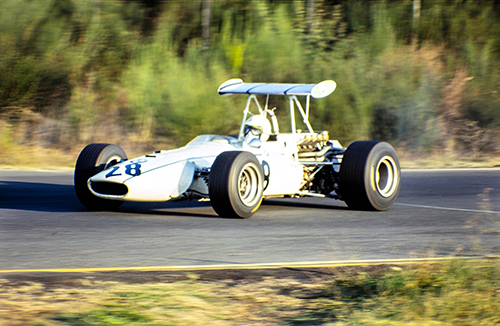
Hubert Hahne tries to get the most out of his Lola-BMW. But, as in the rest of the season,
the car did not cooperate with the driver's efforts.
A very simple observation, however, is that there was a huge gap between these three teams and the rest of the field. The one that came closest to the big trio was BMW, more because of the weight of the name than the performance of the team itself during 1968.
The BMW Formula 2 project began with high expectations, mainly due to the German manufacturer's expertise in assembling cars with excellent performance and reliability. This prospect of success increased even further when it was announced that the German manufacturer would partner its project with Lola Cars Ltd, which had an established name in the competitive single-seater market. After negotiations, it was agreed that while Lola would supply the chassis, BMW would be responsible for the mechanical part of the car, especially the engine.
But it didn't take long for this expectation to turn into pure disappointment. The BMW team's first two years in F2 (1967/'68) were 'difficult', to say the least. The cars were not producing the expected results and in most races the machines were struggling to keep pace, even against backmarkers. The main cause for this problem was BMW's insistence on using its own engine, as opposed to the more traditional and proven 1.6-litre Cosworth FVA. This statement is based on the results obtained by Lolas with Cosworth engines (used by the works Lola team in F2) versus those with the Apfelbeck engines from the BMW team.
With the exception of Ferrari, which produced the Dinos, BMW was the only one to take an independent path from the Cosworths – and it would pay a high price for it at the beginning of its journey in F2. But the end to the season meant the end of a cycle, a time of learning that could be welcome before the start of 1969.
For Rome, it was up to the duo of Hahne and Siffert to represent the BMW colours. Hubert Hahne, for his part, was the team's main driver between 1967 and 1968, always having by his side a motorsport star as his teammate. First it was Surtees, then Jo Siffert, who from 1968 took on the role of leader of the BMW F2 team. Both the Swiss and the German were equipped with identical machines: the Lola-BMW T102, powered by the Apfelbeck M12 engines.

Clay Regazzoni had another poor race in Vallelunga, demonstrating that the Tecnos still suffered
when challenged by a stronger competition.
For those who liked to make high-stakes bets, a driver able to upset the heavyweights on the grid was the still unknown Peter Gethin. The Briton had achieved some good results during the year and would certainly come prepared for the Rome GP after the excellent second place he achieved a week earlier in the F2 non-championship race at Albi (France).
Complementing the final entry list, other names would certainly provide entertainment for the spectators: Swiss Clay Regazzoni, who would be the only representative of the official Tecno team, with one of the new PA68 models, while Scuderia Picchio Rossa took the road to Rome with three cars, having secured a great line-up of Italian drivers: Carlo Facetti and Enzo Corti, plus a seasoned Corrado Manfredini. In addition to these, another half dozen other small teams headed to Vallelunga, making the total of 23 machines expected for that October weekend.
The big absentee for the meeting was undoubtedly Jochen Rindt, the most recognised face of the European F2 season. This was mainly due to the Austrian being in a phase of self-preservation, with his attention directed towards the final races of the 1968 Formula 1 season. Furthermore, there was the issue regarding the focus of the Roy Winkelmann Racing team (with which Rindt competed in F2 races) which aimed to meticulously prepare the Austrian's Brabham for the upcoming Argentine F2 Temporada, an event that was scheduled to happen in December.
Practice sessions
For the timed sessions, the organisers decided on introducing an innovation. Instead of the classic ritual of drivers being assigned to their starting positions based on their fastest laps, the Rome GP would define the starting order based on an average of the three best times achieved by each driver. Therefore, each driver was obliged to do at least three fast laps to reach the minimum classification index for the race.
The explanation given at the time by the race promoters was that such a scheme would recognise drivers not only for their speed but also for their consistency, so there was no point in doing a fantastic lap while the other two laps were terrible.
Therefore, both Friday and Saturday were highlighted by the drivers' audacity and desperation to set three reasonable laps. Brambilla and De Adamich Ferraris dominated the qualifying sessions, but that didn't mean that the life of the red cars was easy: the seven best classified drivers were less than 0.5s apart – a negligible margin of time.
Even so, the Italian duo held off the pressure of the competition, with 'Tino' Brambilla securing first position on the grid with a time of 1.16.40 alongside De Adamich with a time of 1.16.46. Derek Bell, in the third Ferrari-Dino, established himself as seventh best with a time of 1.16.96.
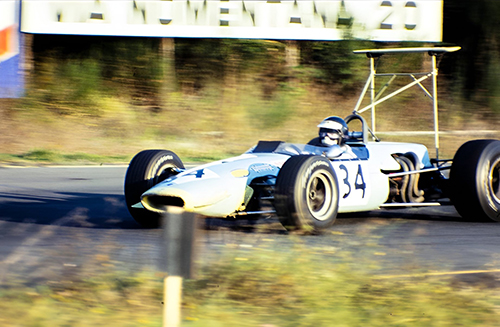
Peter Gethin in the Frank Lythgoe Racing Brabham BT23C.
The driver who came closest to threatening Ferrari's one-two front row was Peter Gethin, who was less than 0.04s away from stealing second place from Andrea De Adamich. Apparently, the Briton would continue his good run of performances, being the biggest danger to the dominance of the Scuderia drivers.
The fight for positions on the race grid in Rome were not just limited to the front of the field. In the back, a fierce battle was taking place as the organisers had established that only 21 of the 23 cars present would qualify for the race on Sunday.
In the end, the driver securing last position on the grid was Italian Corrado Manfredini with a time of 1.21.10. Those less fortunate were Brits Chris Meek (Bill Jones Racing, Brabham BT10) and Robs Lamplough (Frank Manning Racing, McLaren M4A) who were both bumped from the grid.
The race in the Eternal City
The race's system of contest would also rely on the 'average' factor to define its result. Explaining this better, the Rome GP would be held in two heats each lasting 40 laps, with the driver who had the lowest combined time of the two heats declared the winner of the GP. Since lap times under racing conditions at the circuit were close to the 1.20s, it was expected that each heat would last roughly 50 minutes.
Before the race had even started, the circuit claimed its first victim of the day: Alistair Walker, in his own private-entered Lola T100, would not start due to problems with his machine. Therefore, only 20 cars would line up in the first heat of the race.
As soon as the flag dropped, the Ferraris of Brambilla and De Adamich consolidated their positions at the front of the field. Right behind was a fast and surprising Gethin, with his Brabham-Cosworth BT23C. Regazzoni, who had started fourth in a Tecno, quickly began to drop positions due to a series of electrical problems that affected the car's ignition system.
It didn't take long for a big gap to begin to form between the top three (both Ferraris and the lone Brabham of Gethin) and the group that was right behind made up of Siffert's BMW, the Matras of Beltoise and Pescarolo, as well Bell's Ferrari. Even though it had symbolic value, the fight for fourth place was hotly contested, with the Matras incessantly attacking Jo Siffert. 15 laps into the race, the Swiss driver began to falter under pressure from the French squad and, four laps later, the driver gave up the battle once and for all when the Apfelbeck engine suffered yet another of its traditional failures – this time due to the fuel pump.
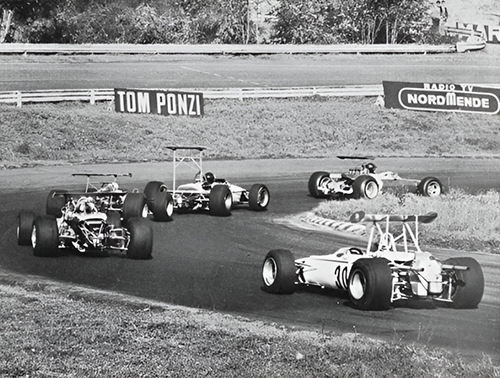
The drivers tangle with the slowest part of the Vallelunga circuit,
the section between the Semaforo, Tornantino and Esse curves.
Returning to the skirmish for first, Brambilla continued in the lead, with De Adamich protecting his teammate's rear. Peter Gethin was close by, waiting for a mistake from any of the Scuderia cars. But, as the laps went by, the Brit soon realised that the Italian pair were having a steady day and only stronger pressure would yield something greater for Frank Lythgoe Racing's Brabham.
In the final ten laps, Gethin changed his tactics and started to put some pressure on De Adamich. But the Italian fended off the Brit's offensive, while in the interlude between the attacks he was able to put some backmarkers between himself and Gethin. One of them in particular, Hubert Hahne, played a tough game with the Brabham driver, allowing De Adamich to open a small but helpful advantage to secure second position for the rest of the race.
De Adamich's greatest contribution was not to himself, but to his teammate Ernesto Brambilla. The battle between the Ferrari's second car and the Brabham had allowed Brambilla to have some moments of peace, which were essential for the Italian to secure victory in the first heat of the Rome GP. 'Tino' finished the race in 51.31.0, with an advantage of just two seconds over De Adamich in a well-deserved second place.
Despite his efforts, Gethin had to settle for third place – an excellent result, but one that could have been better. The French duo of Beltoise and Pescarolo had secured fourth and fifth for Matra, whilst an apathic Derek Bell was far behind his Italian teammates, with a modest sixth in the third Ferrari.
Once the first heat was over, it was time to give both machines and drivers a little break. But it was short, as another 40 laps had to be completed before the end of the day. This time, 19 cars lined up at Vallelunga (Kurt Ahrens had had terminal problems with his Brabham in the first heat and therefore would not start the second) to compete in the final race of the Rome GP.
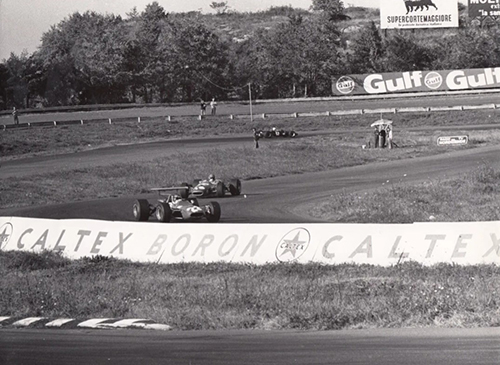
Carlo Facetti (#22) was a rather familiar face in the F2 grids of the 1968 season.
Behind him is probably Enzo Corti's Brabham (#18).
Quickly, the track was cleared and once again the cars went down at full throttle on the main straight of the circuit. The Ferraris quickly tried to defend their positions and to the delight of the huge crowd that filled the venue's grandstands, Brambilla and De Adamich were still dictating the pace of the race at the end of the first lap.
Even though the story plot seemed the same for the Maranello cars, right behind them a different story developed. This time, it was not Peter Gethin who was coming after the Italian duo, but J.P. Beltoise! The Frenchman had managed to make a better start and surprised the British driver, but Gethin wouldn't allow the Matra driver to get away with that so easily. In just a few laps, the Briton arranged a payback, retaking third, and now, Gethin and his Brabham set their next target on De Adamich's Ferrari.
With the loss of third position, there wasn't much Beltoise could do. Since the Matra seemed far from its highest standards of performance that had led to so much success during the year, the French driver resigned himself to fourth. Right behind was Henri Pescarolo, who tried to catch up to his teammate. The two Matras were now in formation, with the simple objective of finishing the race.
In sixth and seventh, an interesting fight was developing between Graham Hill's Lotus and Derek Bell's Ferrari. The circuit's fast corner did not allow for many overtaking opportunities, meaning that Hill who was in pursuit of Bell failed to find a good place to pull off a move. Another factor that favoured Ferrari's defense was that the Italian machine was more suited to the track than the British Lotus, suppressing to a certain extent the driver's lack of performance, as Derek Bell later admitted to Italian reporters that he was no big fan of the Vallelunga circuit.
Even though the Briton's Ferrari continued to fight for a midfield position, the same could not be said for his Italian teammates who until the final quarter of the race were leading comfortably. But this lull wouldn't last long, as Peter Gethin's car seemed to get bigger and bigger in De Adamich's mirror, before the Englishman went on attack mode in the final laps of the race. The outcome of it? With two laps to go before the chequered flag, the Briton executed a beautiful move to finally manage to overtake De Adamich's Ferrari. That was the best that Gethin could achieve, as there was no more time to close the gap between himself and Brambilla.
So once again a red car crossed the finish line in Rome first, and for the second time that day, it was driven by Ernesto 'Tino' Brambilla. A gap of two seconds separated him from Gethin, with another two seconds in between the Briton and De Adamich, who rounded out the top three. In the lower positions, there was not much movement during the race, with almost all drivers maintaining their original starting positions.
After finishing both heats, what mattered now was the sum of the times, which would define the final podium of the Roman race. Brambilla, with victories in both races, was the uncontested winner of the XX Gran Premio di Roma, with a total time of 1.43.02.7. However, the fight over second overall was a lot stronger, due to the duel between Andrea De Adamich and Peter Gethin in both races. In the end, the Italian had done better with a combined time that was two seconds quicker than Gethin's. The conclusion was that the time lost by Gethin in the first heat while trying to overtake the backmarkers had cost him second place.
Those who had no reason to complain were the fans who shortly after the final result was announced invaded the track. Due to the difficult times the Scuderia Ferrari was going through, any success was an explosion of joy for the most passionate tifosi. A victory in Italy with a Ferrari, with an Italian driver, in the midst of a crisis – perhaps this is the epitome of what Scuderia Ferrari is…
Why to read me?
As always in this last section, I like to explain the whys of writing and also reading this text. Well, the main reason to remember the 1968 Gran Premio di Roma is that this race was the last victory of an official Ferrari F2 car on the European continent. Even though the Tipo 166 F2 (and its evolution, the 246 T) still achieved some success around the world, especially in South America and Oceania in the following two years, the vehicle was unable to remain among the most competitive cars on the grid in the following European F2 season. Due to the lack of funds to develop the cars and the increasingly overwhelming number of Cosworth engines on the grid, the Dinos simply couldn't handle the pressure.
Furthermore, the race in Rome was important for some other picturesque points. The most significant of these was, without a doubt, the arrival on the scene of a new generation of Italian drivers: in addition to Andrea de Adamich and Ernesto 'Tino' Brambilla, who were the most prominent figures of this crop, other names such as Carlo Facetti and Enzo Corti began to become more common on the lips of those attending F2 and touring car events. Even though this generation wasn't made up of huge talents compared to those that shone on the Italian circuits in the fifties and early sixties, it was in any case a signal that the desire to race had not disappeared in the boot-shaped land.
Another driver who deserves attention for his participation in the Roman race was a certain Max Mosley. This name will always catch the attention of anyone passionate about motorsport, whether it's because of his troubled tenure as FIA president for 16 years, his controversial personal life, or even other notable facts such as his part in the founding of March Engineering. Despite the rights and wrongs in his own personal life, Mosley's contributions to single-seater motorsport are undeniable.
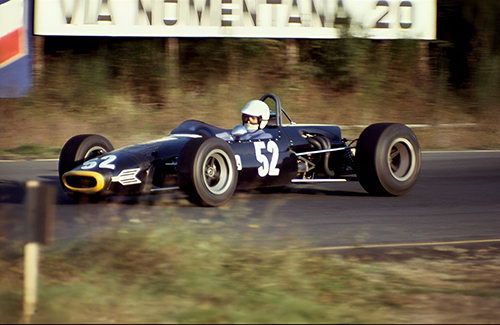
Before establishing the March Engineering, Max Mosley had his share of driving experience.
In Rome, the driver raced a Brabham BT23C prepared by Frank Williams Racing Cars.
It is worth noting that, before all the turmoil, Mosley was a simple amateur driver who throughout the 1966-'68 seasons participated in several minor F2 and F3 races. Being part of the squads of the London Racing Team and Frank Williams Racing Cars, the Briton had the opportunity to compete in events with some of the stars that would shine in the seventies. The race in Rome, however, marked Mosley's last regular appearance in a sanctioned F2 event, as a race accident at the beginning of 1969, in addition to his increasing involvement with the March project, sealed the end of Mosley's driver career.
Moving on to the machines, another peculiar factor that marked the Rome GP was the extraordinary performance of the Bob Gerard/Merlyn Racing Merlyn Mk12 raced by British driver Alan Rollinson. An eighth place in the final result may seem a disappointing result for a larger team, but for Colchester Racing Developments, the company that manufactured the Merlyns, the result was spectacular.
The company had been reasonably successful in producing Formula 3 cars, but when it made the jump to F2, this proved to be a bigger step than the company could handle. Even so, luck smiled for the team in Rome, the place where Merlyn achieved its greatest success in its shortlived existence in the category.
